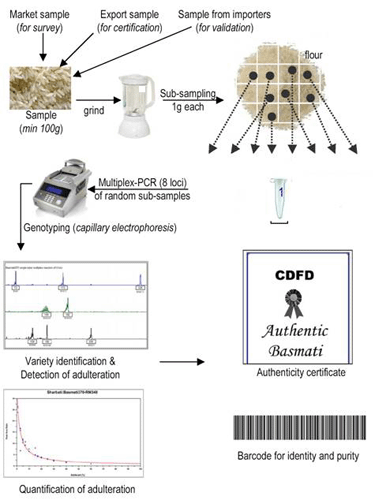Sampling procedure and DNA extraction
From the samples received at the Centre, at least 50 g of grains from each sample is powdered and the remaining sample is stored for three months. During this period, if required, the sample is re-used for DNA analysis. From the powdered sample, eight sub-samples of 1 g each is drawn (Fig. 1), from which 100 mg of grain powder is collected for DNA extraction. DNA is isolated using Qiagen DNeasy plant mini kit and quantity and quality of the DNA (at 260/230 and 260/280 absorbance) are verified using UV-Vis spectrophotometer.
PCR amplification
The PCR is performed using the "Basmati VerifilerTM Kit" (Labindia) (Licensed by CDFD to Ms. Labindia under license transfer agreement) and the protocol is followed as per the details provided therein. (PDF Basmati Verifiler Kit)
Capillary electrophoresis (CE)
The fluorescently labeled PCR products are mixed with 0.3 µl of GeneScan-500 ROX (6-Carboxy-X-Rhodamine) size standard (Applied Biosystems, USA) and 10.2 µl of Hi-Di Formamide (Applied Biosystems, USA), electrophoresed by capillary electrophoresis on an ABI PRISM 3100 genetic analyzer (Applied Biosystems, USA) according to the manufacturer's instructions. Subsequently, fluorescent DNA fragments are resolved using the GeneScan version 3.7, and allele size and peak-area of the true peaks are determined by Genemapper version 3.7 (Applied Biosystems, USA).
Note: - In case of adulterated samples, each experiment is repeated thrice, starting from the DNA extraction, to confirm the extent of adulteration of Basmati rice with non-basmati rice grains.
Quantification of adulteration
The quantity of an amplified PCR product is represented by peak area (measured in relative fluorescent units, rfu). The adulteration is expressed as a percent fraction to that of pure basmati:

Where,
A is the rfu of the adulterant and
B is the rfu of the main variety.
Issue of Basmati DNA Test Report
Once the DNA analysis of a given rice sample is completed, the duly signed authenticity certificate, which contains the details of percentage of adulterated rice present in Basmati rice sample, is provided to the sender. The scanned copy of the certificate may also be sent by e-mail on request. The certificate is formatted as per the guidelines stipulated by the management committee of the APEDA-CDFD centre.

Fig. 1 Picture showing the protocol followed at the APEDA-CDFD centre for Basmati DNA analysis
|